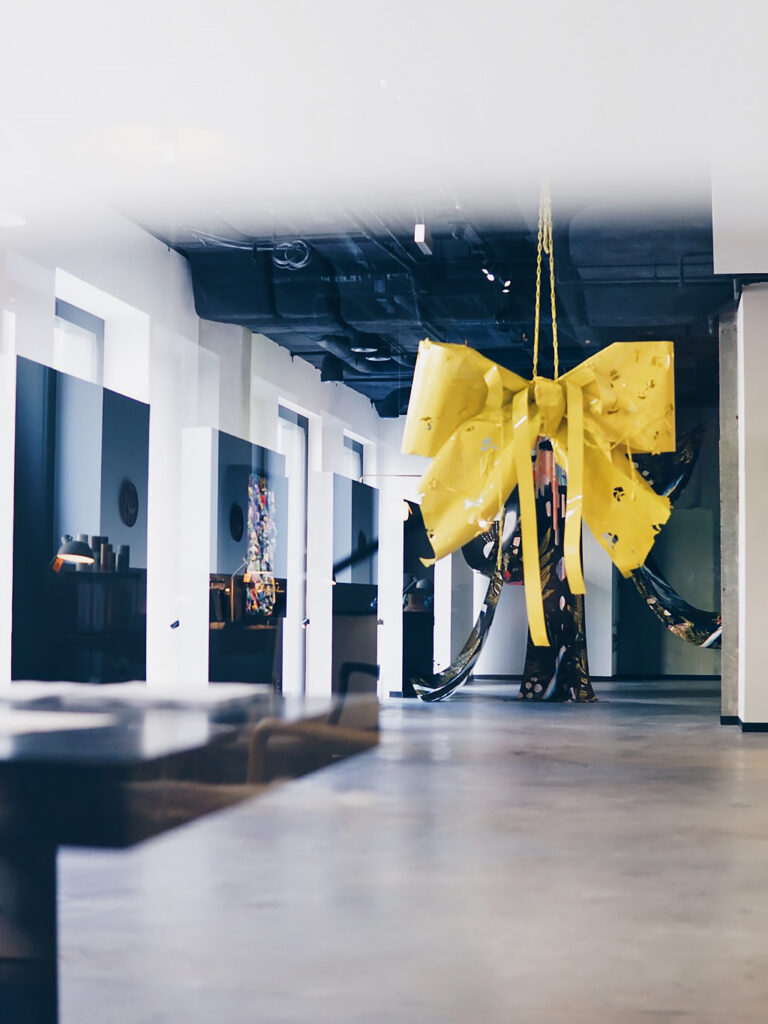Hannah Sophie Dunkelberg, Kaja Gadomska, Magdalena Karpińska, Marta Nadolle, Paulina Włostowska
BEL(L)A
Sep 28 – Oct 21, 2023
Hotel Warszawa
Powstańców Warszawy Sq. 9
(entry from the boutique, Świętokrzyska)
Opening Hours:
Tue–Sat: 4 – 7 pm
Co-organisers:
Gunia Nowik Gallery, LETO, Polana Institute

Bel(l)a
or the tale of the power of woven fabric
The modern history of woven fabric is intertwined with post-war reconstruction. In 1950, the Warsaw Institute of Industrial Design (originally: Bureau of Supervision of the Aesthetics of Production) was established, and along with the strong need to furnish public and domestic interiors, emergence of the "Polish school of woven fabric" ensued. As a result of the activities in the Sopot School (initiated by Józefa Wnukowa), the "Ład" Cooperative, the silk factory in Milanówek, and the linen factories in Żyrardów, the boundaries between what was industrial and what was artistic began to blur.
Experimental large wall quilts designed by the Sopot artists – unique fabrics associated with specific places – often served as backdrops for festival performances. Ładów jacquards filled and complemented the architecture of many public buildings, replacing woven wool tapestries and kilims. Hand-painted silks delighted with their precision and the quality of their craftsmanship. Moreover, decorative art fulfilled an important need for representation at that time. It proved its power by seducing the authorities, who eagerly commissioned woven fabrics as an essential element in interior decorations (Czasznicka's fabric from 1946 in the rebuilt Sejm of the Polish People's Republic) or government gifts (e.g., the Ministry of Culture and Art commissioned three tapestries for Joseph Stalin).
From the 1960s and 1970s onwards, woven fabric began to break free from it’s strict utilitarian confines, evolving from just being a backdrop for exhibited works (canvas walls) to being an artwork exhibited in its own right. It had already achieved the status of a work of art, but it seems to be primarily associated with functional objects, belonging to the domain of applied and decorative art.
What if we were to position fabric in relation to painting and sculpture, not as something complementary or supplementary, but as an equivalent medium? Furthermore, as a medium that allows for the experiences of various forms of artistic expression, and surpasses their possibilities? Fabric would work excellently, for example, as a "movable mural," a work of art that can be used repeatedly in different spaces. This is tempting not only because of the varied formats of the works, the decorative and handbrushed quality of the visual layer, as well as the current playing with textures, the contrasts between hard and soft, smooth and rough.
The Bel(l)a exhibition brings together five artists: Magdalena Karpińska and Paulina Włostowska (Polana Institute), Kaja Gadomska and Marta Nadolle (Leto Gallery), and Hannah Sophie Dunkelberg (Gunia Nowik Gallery). Through the dialogue in their works, the power of fabric is revealed and reflected in the diversity of the techniques used. The artists create jacquards, screen-printed patterns, painted silk, embroidery and patchwork based on the experiences of their predecessors. It is worth noting, however, that the ongoing emancipation of woven fabric in the visual arts extends not only for the medium itself, but also in the works that go beyond its material, as demonstrated by works in wood and steel.
Sebastian Kańczurzewski
 Design by Post Studio Noviki
Design by Post Studio Noviki